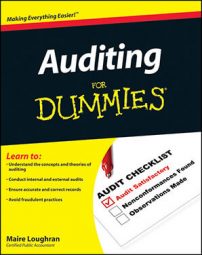As an auditor you have to test security investments such as your client’s stocks and bonds. Testing investments during an audit is no different from testing any other financial account, such as cash. You must make sure that the amounts shown as investment assets aren’t materially misstated and that all income and changes in an investment’s value are properly recorded.
First you have to confirm your audit client’s security investments:
If your client uses a custodian — an outside agent who safeguards the securities — you request a confirmation. The confirmation should address what types of securities the company owns. If the securities include stock, you must find out how many shares the company owns and the stock’s fair market value (a best estimate of the price the stock would fetch if it were sold that day). Receiving confirmation from the client’s investment custodian is typically adequate to verify the existence of the investment.
If your client maintains custody of its investments itself, you confirm their existence by physically examining the securities. It’s always a good idea to check the minutes of the corporate meetings to confirm the authorization to purchase each investment.
You should also confirm that all investment-related interest and dividend income has hit the income statement as revenue. On the flip side, if you see any investment income hitting the income statement that can’t be matched to an investment, that situation indicates that you have a completeness issue — all investments aren’t reflecting on the balance sheet.
To test a client’s investments, you mostly look at how a security is categorized and whether it’s presented on the client’s income statement or balance sheet. The three categories of debt and equity securities are held-to-maturity, trading, and available-for-sale. While checking out the classification, you also audit the value of an investment and how that value is determined.
Here’s how your client should be treating and valuing each category of investments:
Held-to-maturity: These are debt securities such as bonds that your client intends to hold until they come due. Held-to-maturity securities are held at their amortized cost, which means any difference paid for the bond versus its face value is recorded as a premium or discount. This is an advanced accounting topic, so dust off your generally accepted accounting principles (GAAP) guide if your audit client has these types of securities to make sure it’s recording the transactions properly.
Trading: Debt and equity securities that your client purchases to sell in the short term to make a profit are recorded on the balance sheet initially at cost. Then, as their value fluctuates, they’re recorded at fair market value with any gain or loss going to the income statement.
Available-for-sale: A catch-all category, these debt and equity investments are defined by what they’re not: They don’t fall into either the held-to-maturity or trading category. They’re initially recorded at their cost, and then your client should be recording them at fair market value with any gains or losses reported in shareholder’s equity.
Part of your testing should be to confirm the beginning investments balances to the prior year financial statements. So if the client is on a calendar year-end, you look at the value of the investments as of December 31 and check to make sure the same values are reflected as of January 1. If the company is a continuing client, this information will be in your workpapers. Otherwise, check out the company’s prior year financial statements.

